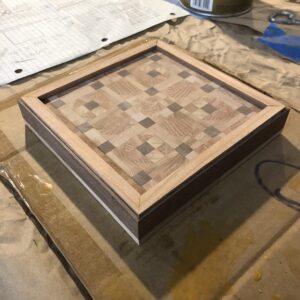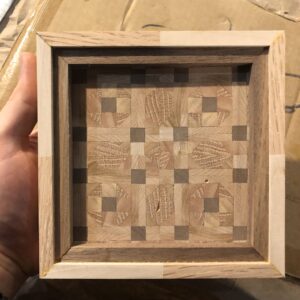I’m working on a small box (roughly a 6″ cube) with a decorative lid. The lid consists of a 3/8″ thick panel made like a miniature end grain butcher block cutting board which floats in dados in a mitered frame. The end grain panel was too loose so I added floating shims in the dados that made it fit snugly. Do you think that the wood expansion when the humid summer arrives will be enough to split the panel or break the frame? How do expansion and contraction in an end grain butcher block compare to expansion and contraction in a solid board?
I’ve struggled to find specific information about wood movement in end grain butcher blocks, and I haven’t been able to find ANY information about miniature end grain butcher block used decoratively (is this because it’s a bad idea to begin with? Or because there are easier ways to create a similar effect?)
Everything I’ve been able to find online about wood movement in general says that when working with such small sizes it isn’t quite as big a consideration as in larger pieces, but I still tried to avoid doing anything I know would be problematic (like gluing end grain directly to face grain or something).
I’ve already glued up the lid (see pictures) so to some extent this question is rhetorical — I don’t think I could disassemble it without damaging it. Maybe come June this piece will just explode and it’ll be a learning experience. If the consensus on this forum is that this is a terrible idea and the box is likely to fail then I can just make a new lid with a different design.
Thanks!

















Replies
Total crapshoot. So many different sizes and species it coul fail anywhere or nowhere... 50-50. If you left some room around the inside of the frame groove the top should remain intact. If you reinforced the miters all the better.
What did you seal the lid with? If you used oily woods, which tend to resist finishes, you'll have expansion/contraction. But as MJ said, not at a level I'd worry about. Don't fret none.
Mikaol
It's all raw wood right now, black walnut, hard maple, cherry, and red oak -- I was planning to do two or three coats of polyurethane when the assembly is finished. All the glue ups are titebond 2.
I think of it this way — if the butcher block were a single end-grain slice from a larger timber, movement would primarily be perpendicular to the quarter-sawn axis, with little movement along said axis and essentially no movement in thickness. Since this butcher block has grain orientation in many horizontal axes, the overall movement of the panel should be pretty well distributed, and may not amount to much in any given direction. Not knowing the lateral tolerance of your shims or the humidity differentials the finished box will likely experience, I would go ahead and finish it and hope for the best. Good Luck!
Actually the information on expansion/contraction is widely available , it is simply the expansion factor tables for wood under different moisture conditions. The complicated part is factoring the different wood spieces, their dimension and the orientation of the growth rings but assuming an overall expansion factor would be close enough. The same calculation that applies to the wood movement in a board would also apply to a butcher block, so for a 6 inch width, I would expect about 1/32 ‘’ seasonal wood movement.
See the following post for an example of just how extreme wood movement can be in a butcher-block glue up, even when it's quite small.
https://www.finewoodworking.com/forum/diffeential-wood-movement
The post shows some illustrations of the effects of shrinkage in a small oak butcher block glued solidly into a frame. Such a thing only 6" X 6" will show some significant cracking from shrinkage following a move from workshop (unheated but not damp) to inside the house.
If a butcher block glue up is not framed but left to float in it's frame, with significant expansion/contraction room, it won't crack. The blocks will all shrink and expand more or less in synch with each other. Different species do show differentials in their expansion/contraction rates but not enough to cause cracks in smaller sizes such as yours.
It's the differential movement between long grain and cross grain expansion/contraction that's large and the cause of butcher block cracking or other self-destruction.
Perhaps you should have left your original un-shimmed frame and accepted that the butcher block panel would move in it?
Lataxe
Since it's already built, finish it and watch. I'll be interested to see how it goes, if you can keep us updated.
In 6” we’ll seasoned wood not much maybe a maximum of 1/16”
Thank you all for your input, judging from all of your responses it looks like it's probably worth crossing my fingers and finishing the piece with this lid. I'm kicking myself for not leaving more space in the dados with the shims, but at the glue up I could still shift the panel around a little bit so hopefully it'll hold.
I'll post pictures of the finished box on this thread, and then hopefully that will be that and I won't have to post pictures of the self-destructed box this summer!
This forum post is now archived. Commenting has been disabled